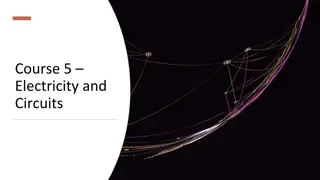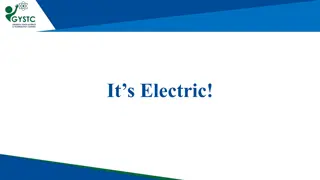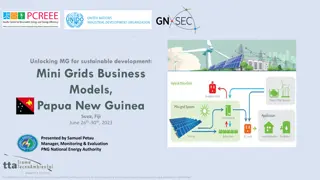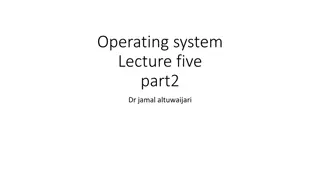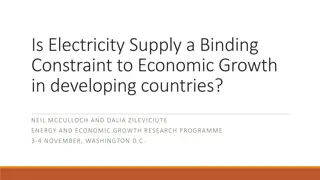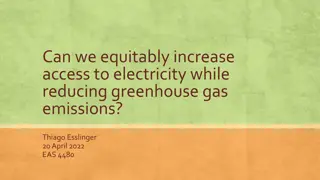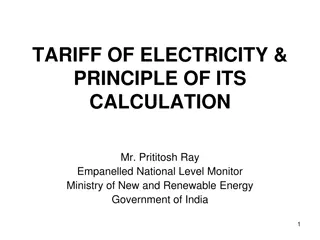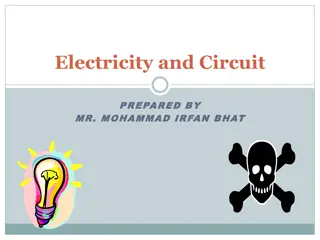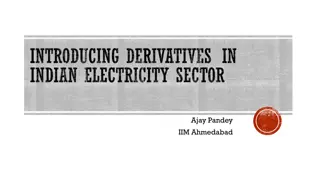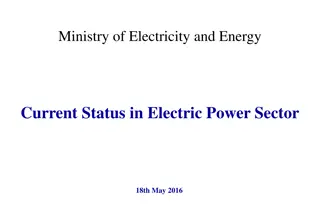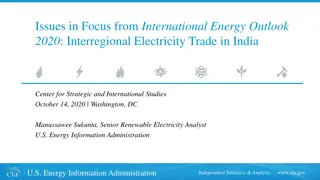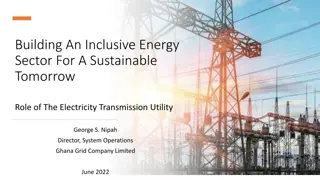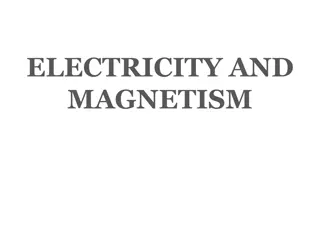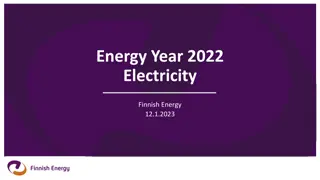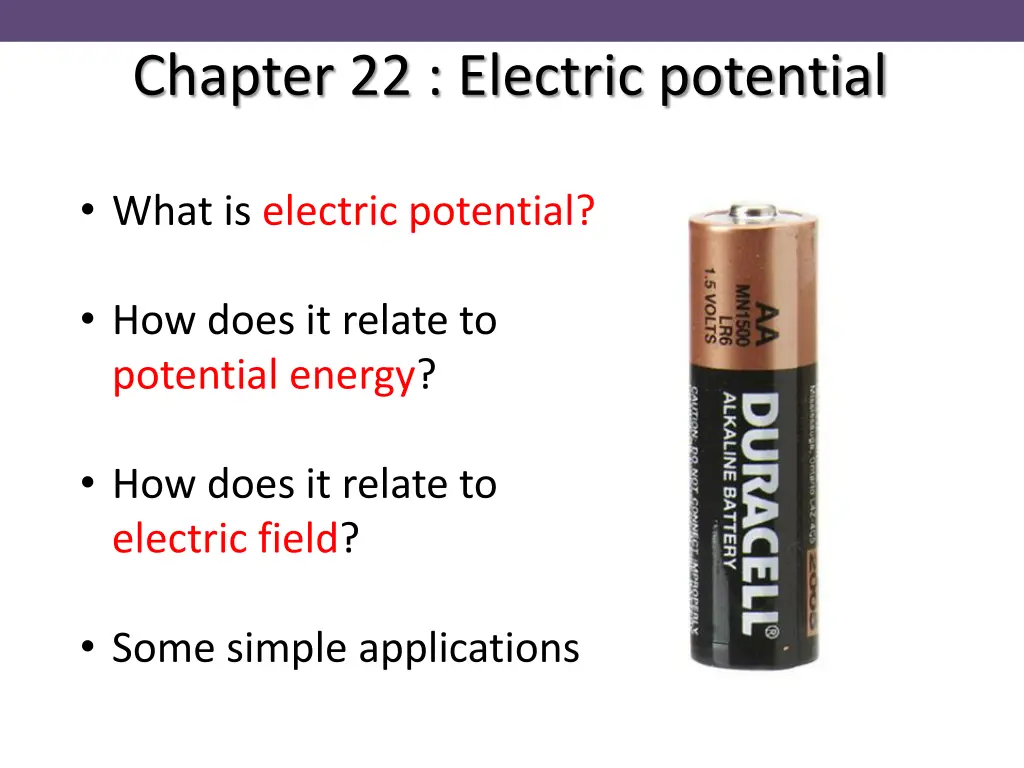
Understanding Electric Potential and Potential Energy
Explore the concept of electric potential, its relationship to potential energy and electric field, and simple applications. Discover how a battery's voltage indicates the electric potential difference and delve into the significance of volts and the work required to move charge. Uncover the essence of potential energy as stored energy in a system that can be converted and released into other forms, such as kinetic energy. See how the difference in potential energy plays a pivotal role in conservation of energy principles in mechanical systems.
Download Presentation

Please find below an Image/Link to download the presentation.
The content on the website is provided AS IS for your information and personal use only. It may not be sold, licensed, or shared on other websites without obtaining consent from the author. If you encounter any issues during the download, it is possible that the publisher has removed the file from their server.
You are allowed to download the files provided on this website for personal or commercial use, subject to the condition that they are used lawfully. All files are the property of their respective owners.
The content on the website is provided AS IS for your information and personal use only. It may not be sold, licensed, or shared on other websites without obtaining consent from the author.
E N D
Presentation Transcript
Chapter 22 : Electric potential What is electric potential? How does it relate to potential energy? How does it relate to electric field? Some simple applications
Electric potential What does it mean when it says 1.5 Volts on the battery? The electric potential difference between the ends is 1.5 Volts
Electric potential 1.5 V 230 V 100,000 V So what is a volt?
Electric potential The electric potential difference ? in volts between two points is the work in Joules needed to move 1 C of charge between those points ? = ? ? W = work done [in J] q = charge [in C] V = potential difference [in V] ? is measured in volts [V] : 1 V = 1 J/C
Electric potential The electric potential difference ? in volts between two points is the work in Joules needed to move 1 C of charge between those points ? = ? ? The 1.5 V battery does 1.5 J of work for every 1 C of charge flowing round the circuit
Potential energy What is this thing called potential ? Potential energy crops up everywhere in physics
Potential energy Potential energy U is the energy stored in a system (when work is done against a force) e.g. force of gravity ? = ?? Work = Force x Distance ? = ? = ?? ? ? = ??
Potential energy Potential energy may be released and converted into other forms (such as kinetic energy) Work is done, increasing the potential energy
Potential energy Potential energy difference is the only thing that matters not the reference (or zero) level For example, applying conservation of energy to a mechanics problem: Final energy = Initial energy ???????+ ???????= ?????????+ ????????? ???????= ?????????+ (????????? ???????) Difference in potential energy
Potential energy Potential energy difference doesn t depend on the path only on the two points A and B
Potential energy Potential energy U is the energy stored in a system second example ? = ?? e.g. stretching a spring Work = Force x Distance Force is varying with distance! ? ? = ?? ?? =1 2??2 ? =1 2??2 ?
Electric potential e.g. moving a charge through an electric field ? ? = ?? ? ? (minus sign because the force is opposite to E) ? = ?? ? ? = ? ? Work = Force x Distance Potential difference ? is work needed to move 1C of charge: ? = ? ? ? = ? Equate: ? ? = ?? ? ?
Electric potential Electric field is the gradient of potential ? = ? ? High V Low V ? ? ? Positive charges feel a force from high to low potential Negative charges feel a force from low to high potential ?
Two parallel plates have equal and opposite charge. Rank the indicated positions from highest to lowest electric potential. - - - - - - - - - - - - - A A B B D D C C + + + + + + + + + + + + + + + + 1. A=C, B=D 2. A, B, C, D 3. C, D=B, A 4. A, B=D, C 0% 0% 0% 0% 1 2 3 4
Electric potential Analogy with gravitational potential Gravitational potential difference exerts force on mass ? ? Electric potential difference exerts force on charge ?
Electric potential Electric field is the gradient of potential ? = ? ? The dashed lines are called equipotentials (lines of constant V) High V Low V ? Electric field lines are perpendicular to equipotentials It takes no work to move a charge along an equipotential (work done = ?? = ?.?? = ??.?? = 0)
Electric potential Summary for two plates at potential difference V ? Electric field is the potential gradient ? =? ? Work W to move charge q from ve to +ve plate ? = ? ? ?
Link to potential energy The electric potential difference ? between two points is the work needed to move 1 C of charge between those points ? = ? ? This work is also equal to the potential energy difference ? between those points ? = ? ? Potential V = potential energy per unit charge U/q
An electron is placed at X on the negative plate of a pair of charged parallel plates. For the maximum work to be done on it, which point should it be moved to? - - - - - - - - - - - - - X X B B D D A A C C + + + + + + + + + + + + + + + + 1. A 2. B 3. C 4. D 5. A or C 6. C or D 0% 0% 0% 0% 0% 0% 1 2 3 4 5 6
Electric potential What is the electric potential near a charge +Q? Work = Force x Distance ? =? ? ? Force is varying with distance, need integral! ?2 ? ? ? ? ? ?2 ?? =? ? ? ? = ? ?? = ? +q Potential energy ? =? ? ? ? +Q ? + Electric potential ? =? ?=? ? ?
Electric potential What is the electric potential near a charge +Q? +q ? +Q + Electric potential ? =? ? ?
Electric potential Exercise: Exercise: a potential difference of 200 V is applied across a pair of parallel plates 0.012 m apart. (a) calculate E and draw its direction between the plates. The electric field is the gradient in potential ? ? 200 0.012 = 1.7 104 ? ? 1 [?? ? ? 1] ? = = ? = 200 +ve plate ? -ve plate ? = 0
Electric potential Exercise: Exercise: a potential difference of 200 V is applied across a pair of parallel plates 0.012 m apart. (b) an electron is placed between the plates, next to the negative plate. Calculate the force on the electron, the acceleration of the electron, and the time it takes to reach the other plate. Force ? = ?? = ( 1.6 10 19) (1.7 104) = 2.7 10 15 ? ? ?=2.7 10 15 9.1 10 31 = 3.0 1015 ? ? 2 ? = ?? Acceleration ? = +ve plate 2? ? ? =1 2??2 Time ? = ? ? 2 0.012 3.0 1015 = 2.8 10 9 ? ? = -ve plate e = 1.6 x 10-19 C; me = 9.1 x 10-31 kg
Electric potential Exercise: Exercise: a potential difference of 200 V is applied across a pair of parallel plates 0.012 m apart. (c) calculate the work done on the electron as it travels between the plates. The potential difference is the work done on 1C charge Work ? = ?? = 1.6 10 19 200 = 3.2 10 17 ? +ve plate ? ? -ve plate e = 1.6 x 10-19 C; me = 9.1 x 10-31 kg
Chapter 22 summary Electric potential difference V is the work done when moving unit charge: ? = ?? The electric potential energy is therefore also given by: ? = ?? The electric field is the gradient of the potential: ? = ?/ ? Charges feel a force from high electric potential to low potential


